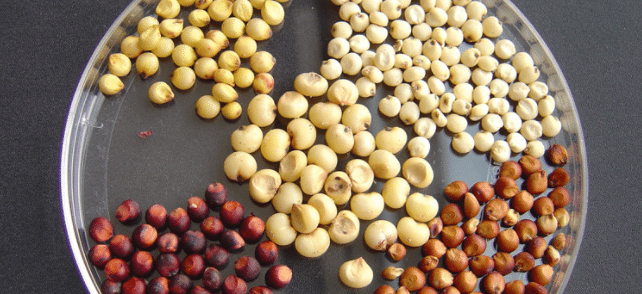Fourth Millennium BCE pottery holds clues to how Neolithic people in Sudan domesticated sorghum.
Establishing the history of sorghum, Africa’s primary staple crop, has been difficult.
The earliest evidence of wild sorghum comes from short-lived hunter and gatherer camps in the Sahara dating to roughly 7,500 BCE. But, the earliest known domesticated sorghum remains dated to 2,000, 1,700 BCE and were found in India, where it is not a native crop. Domesticated sorghum did not appear again in Sudan until the later part of the first millennium BCE, leaving a gap in knowledge of more than 5,000 years.
Sorghum tempered pottery
Enter Dorian Fuller, archaeobotany professor at the Institute of Archaeology, University College London, who along with his team met Frank Winchell, an American ceramics specialist who found fourth millennium BCE pottery fragments from the southern Atbai region in eastern Sudan with traces of the earliest evidence of domesticated sorghum used as temper, or an additive to clay.
The sorghum-tempered pottery was found in the 1980s at a site called KG23 by a team of archaeologists from Southern Methodist University (SMU) in Dallas, Texas. They carried out an archaeological survey that located sites associated with several Neolithic cultures in Sudan, one of which is called the Butana Group.
KG23, at roughly 120,000 square meters, was the largest site in the region and was occupied, based on radiocarbon dating, from about 3,500 BCE to 2,500 BCE.
The thick accumulation of debris in KG23’s rubbish dumps, says Winchell suggests that, “people pretty much live on that site long term and probably throughout the year.” The ancient environment around KG23 was wetter than it is today, with a small seasonal river nearby and alluvial soils suitable for crop cultivation.
The team took the pottery fragments back to SMU, where Winchell analyzed them for his PhD dissertation. One type of pottery stood out, Winchell recalls: “the paste was distinctive; you could tell the potter had thrown in chaff and sorghum seeds as temper to bind the clay together, so it would not break during firing.”
Upon closer inspection, Winchell considered it could be domesticated sorghum, but without analysis his hunch could not be confirmed. So, Winchell waited nearly 30 years. In 2014, Winchell was introduced to Fuller, who was able to analyze sorghum impressions in pottery.
Identifying domesticated sorghum in clay
The trick to identifying domesticated sorghum is knowing what to look for, which Fuller explains, “is whether or not there is an attached torn rachis, or little stalk at the base of the spikelet.” Sorghum grains are enclosed in a spikelet and in wild sorghum, the grain pops off in the husk leaving a straight smooth scar. Domesticated sorghum, however, is propagated by human action so the plant becomes torn during threshing, leaving a small rachis stub.
The team made casts of sorghum impressions using vinyl polysiloxane dental mold and examined the seeds under a scanning electron microscope that allowed them to see very fine details, such as single hairs.
The team found that roughly half of the impressions were made from domestic sorghum, providing the earliest evidence of domestication for this crop. However, the other half of the plant impressions in the pottery came from wild sorghum, showing a complex picture of domestication.
Slow and independent sorghum domestication
The results provide further proof that plant domestication was a long process. As Fuller explains, the KG23 sorghum is a snap shot from the middle of its domestication process.
Based on Fuller’s work with other grains, the domestication process often took around two to three thousand years. “So, if it’s a similar rate with sorghum,” according to Fuller, “then I’d expect the process to start at least 1,000 up to 1,500 years earlier, meaning that if this site dates to 3,200 BCE, then we should be looking for sites, which have earlier stages of the process going back to 4,000 to 4,500 BCE.”
To confirm this process, more plant remains from earlier and later sites need to be analyzed.
What is clear, however, is that the Neolithic populations in Sudan figured out how to domesticate sorghum independent of earlier cereal crop domestication in Egypt and Mesopotamia.











